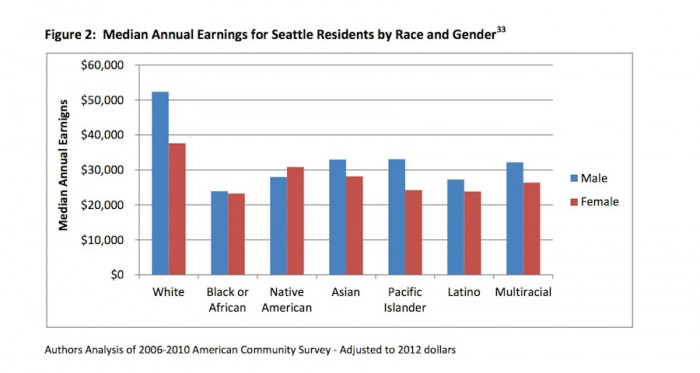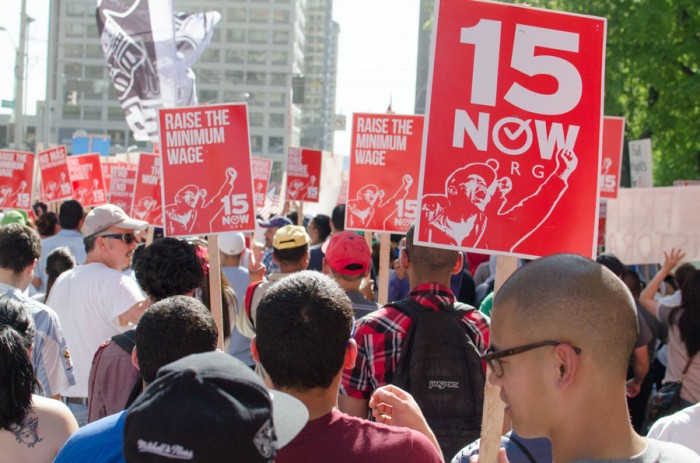Wages will soon be on the rise in Seattle, as businesses begin the slow transition to a newly mandated $15 per hour minimum wage.
Since the measure passed June 2, 15 Now activists have celebrated, the International Franchise Association has filed a federal discrimination lawsuit and small business owners have made dire predictions about their future survival.
But who really stands to benefit from a higher minimum wage?
Puget Sound Sage, an organization that works to provide opportunities for families in the Seattle metro area released a report in April titled “Economic and Equity Outcomes of a $15/hr Minimum Wage in Seattle.”
The group found that jobs paying below $15 per hour in Seattle are concentrated in three main industries: accommodations & food services, health-care & social assistance, and retail.
And another study conducted for the City of Seattle by the University of Washington found that these low-wage industries disproportionately employ people of color. The lowest of the low wage jobs (those paying below $9.32 per hour) are mostly held by Latino, black and Asian workers.
Araceli Hernandez, Programs Director for Casa Latina, a non-profit organization that helps Latino seasonal workers find employment opportunities, also believes a higher minimum wage will empower immigrant communities.
Casa Latina brought their own minimum hourly pay rate up to $15 in 2012 and raised it to $16 earlier this month. Since the 2012 increase they report that there has been no significant impact on the rate of hiring for Casa Latina workers.
“Initially, it did have an impact, but very quickly the number of jobs went back up again,” said Jose Oblitas, the president of the Worker Leaders Committee at Casa Latina’s hiring hall.
Hernandez predicts that the new minimum wage law will have a positive impact on the lives of some of Casa Latina’s workers.
“Women who work as a house cleaners, nannies or caregivers through agencies will benefit,” said Hernandez, noting that the agencies that provide domestic workers typically pay well below $15 per hour right now.
Ubah Aden works as a home care aid through another agency. She currently makes $10.95 per hour, an amount that she says makes it tough to support her three children.
“It will allow not only myself, but other home care aids, to ease the bills, to do something special with their kids, to buy new shoes for their kids that don’t fall apart two months from now,” said Aden, who immigrated to the U.S. from Somalia.
Home care work, she says, isn’t just a job — it’s important work caring for people’s loved ones. She doesn’t feel that her current wages are representative of the value of the work she does.

Aden hopes the $15 minimum wage will be mandated across Washington state, as do other members of the Service Employees International Union (SEIU) Chapter 775NW, which represents over 40,000 long term care workers in Washington and Montana.
Still, it’s hard for some workers to celebrate a pay increase coming next year when they can’t fathom how they will pay next month’s rent.
That’s where a lot of Seattle service workers have found themselves recently: working for wages that aren’t sufficient to afford rising costs of living in the city. Seattle rents increased by over 27 percent between 2009 and the end of 2013, according to a calculation based on research by Apartment Insights Washington.
Abe King works as a dishwasher at the Harvest Vine, a restaurant in Madison Valley. King expressed some concern that people like him who have worked hard to make their way up to wages around $15/hour over the years will suddenly find themselves back at the bottom of the pay scale, alongside those with comparatively little experience or seniority. That’s a surprisingly common sentiment among service workers in Seattle.
But King says his boss, who supported the wage increase, explained it to him in a way that made him realize the community as a whole will benefit from the higher minimum.
“My owner was for it. It’s nice hearing an owner happy about it,” he said, “because of the bigger picture.”
Not all small business owners in Seattle feel this way, though, as reported by the Seattle Globalist earlier this month.
And soon after the City Council passed the minimum wage ordinance, a group of small business owners called “Forward Seattle” unleashed a small army of paid signature gatherers to try to get a more conservative $12.50/hour minimum wage on the November ballot. After it was revealed the voter-sponsored amendments could not be on the ballot until November 2015, they switched tactics to lobbying the City Council to put a slower minimum wage phase-in to voters this year.
It’s not just small business owners who are worried: big business isn’t exactly delighted either. Big retail and service companies like Starbucks and Target will see a significant increase in labor costs. Baristas and cashiers at the Seattle branches of those companies currently make $9.60 and $8.97 respectively per hour, according to Glassdoor.com.
But as business interests protest, the call for higher minimum wages seems to be picking up momentum nationally and garnering attention from around the globe.
The U.S. federal minimum wage lags well behind that of many other developed nations. Earlier this week the International Monetary Fund released a report on the state of the U.S. economy. Among a laundry list of other recommendations the IMF suggested it would make sound macroeconomic sense for the U.S. to raise the federal minimum wage.




Seattle has a very large number of indie coffee shops and I’m betting the baristas aren’t making any $15/hr. Well, they will now; those of them that will still be working.
99.9% of those coffee shops have 100% automated espresso makers that require no more than punching in the number of shots and pushing the “START” button, not too much more difficult to operate than the self-serve soda-pop machines all fast food outfits have now.
My prediction is that in short order the espresso makers will be moved from behind the counter to the FRONT of the counter where customers make their own espresso drinks, completely eliminating the need for a “barrsta” to push the “START” button for you, thereby eliminating the need for the “barista”.
It’s only one more step for the espresso machine makers to add a credit-card swipe unit that auto-charges you for the espresso you make based on the number of shots you dial in. At that point, the only need for an employee is to load the beans in the hoppers. Big enough hoppers, and that need be done only once a day. At that point, many of these shops can then just be converted into totally self-serve kiosks.
Once this equipment gets built, installed and self-serve espresso drinks shown to be successful, the rest of the country will quickly move in that same direction.
spot on!
^ Your prediction is wrong, not even close.
I have given Gary the ability to state the future as if it has already happened. Only problem is that I can only tell people if they’re wrong, not what will happen or provide anything constructive to a discussion. Sorry.
$15 is ridiculous to force small businesses to pay….especially for baristas! They get tips and hardly do much more than an McDonald’s worker…except try and look way cooler doing it.
Small business complain? Take a look at their revenue each year, liquid cash goin for like $500.000 or more, that’s of course if you’re a really low type of business, heathcare? How much does it make a hospital a year? Boom!!! Look at the 8 digit numbers, a cna? Less than 15.000 a year, a humble dishwasher, $8.00 measly an hour, makes about 320 a week, 540 (less taxes) every 2 weeks, $1,200 every month (taxes), then we add it up, rent $1,200 a month (there goes your paycheck) food $150, gas + car insurance (if you can afford it, bet you can’t) add $200 (being the cheap) student loans (if you are a student, I applaud your courage) medical bills (may God have mercy, those tend to be a real heart attack on paper) credit cards (who in todays world does not have a debt?)
Proceeding the analysis, we find that a: companies are just plain cheap, $15 an hour? Think of an investment (listen to the dude behind numbers) employee retention, that’s one, happy workers = good services & happy customers, a happy customer is a returning customer who is not b!tch!ng to pay for the price of a meal (restaurant in downtown, $10 bucks a lunch? downtown? Super crowded & hungry people everyday)
If this article can’t even get Canada’s minimum wage correct then I would have to call in question other facts. There is not one Province in Canada that has a minimum wage less than $10.00/hour.
Better wages don’t take away jobs. They give people more consumer spending ability. Even if the costs of things go up remember so has the minimum wage. Large influx of immigrants willing to work for less is what is killing the middle class. Jobs that used to support a family now barely pay enough for both parents being paid the same wage. Large corporations are making record profits that never trickle down to the workers. The wealthy 1% are not creating more jobs just getting richer.
These economics from the Reagan era have been touted for so long, used for scare tactics of job loss that people have forgotten what it was like to be paid a decent wage for hard work. Immigrants call Americans lazy because why, they won’t kill themselves doing a job for $4.50 an hour? You bet they wouldn’t, why should they. Corporations rely more on workers than workers on them. After all, without workers there’s no production, no product, no sales, no profit.
Workers need to take back jobs and demand a liveable wage. Every other western country does it. Get unions back to do it for you. Demand that your politicians punish companies for taking jobs overseas, or limit what percentage they can. Remember what America is and stands for. It sure isn’t outsourcing and undercutting jobs to immigrants. There will always be jobs for migrant workers, after which they can go home the rest of the year.
The Republican party always talks about the good old days. It didn’t refer to slavery but a time when there was a boom in growth and the middle class. Growth in jobs and wages. Where a family could live on a single income. But years of Reagan economics and fear mongering have left Americans feeling neglected, undervalued and blaming others. If the average person can pay 10-30% in taxes why can’t the wealthy pay their share. Stop listening to bulls#$t. The rich are only getting richer and there are more jobs going out of the country.
Get your politicians working for you. Not for illegal immigrants or the 1% but for the rest of the 98%.
Easy example:
Average Joe pays 20% on $30,000 = $6,000
Rich person pays 30% on $1,000,000 = $300,000
Who’s gonna feel it worse:
the family left to live on $24,000 or
the family left to live on $700,000
Need I say more.
Sorry I went off topic there but it needed saying. No one seems to get it. Least of all the people who really need the money and forgot they had a voice.